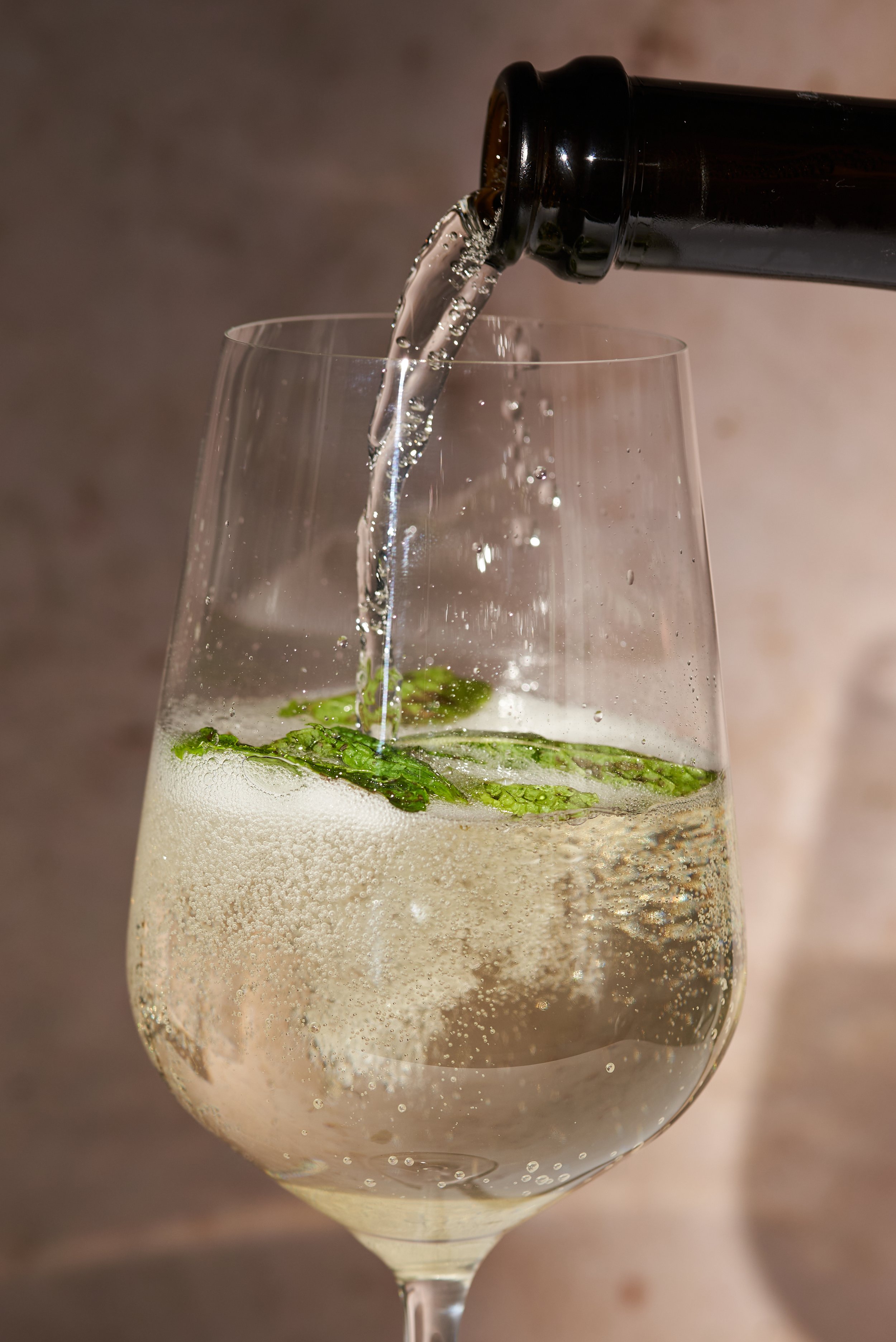hugo spritz.
an herbal, flowery spin on an aperol spritz; perfect for the aperol-averse
Makes: 1 cocktail Prep time: 01 minutes Build Time: 05 minutes jump to recipe.
Another recent favorite of ours has been the Hugo spritz. Maybe it was internet-induced, the same way the caipirinha probably was (thanks, tiktok); but all of a sudden, it started appearing in search results, in conversations, and finally, on our kitchen counter. And thank god for that.
I have a secret, and it’s that I don’t really like aperol spritzes. I’m sorry - they’re way too bitter for me. Not that I’d ever turn one away, but I’d never request it the way I would, say, a mimosa.
I’m sure many out there agree. Negronis, aperol spritz, they take a certain kind of taste bud, one that likes a sharp, bitter taste. Actually, I’d reckon that people who love snacking on olives probably like Negronis, too. Has anyone studied this?
The Hugo spritz is a variation on the classic red spritz, this one sans aperol. Instead, the Hugo has elderflower and mint, which gives it a more refreshing, herbal flavor. They’re probably still not everyone’s cup of tea; elderflower can be hard to swallow too. But for those that like layered floral flavors, like rosewater or gin? This one’s for you.
About elderflower
In reality, the only elderflower liqueur anyone really uses is St. Germaine. For whatever reason, Evan refuses to buy St. Germaine, citing that it’s too expensive (most brands are around the same price). So, we’ve actually never had the “good stuff” in our bar.
Now, Evan does have a point. Compared to other bottles, we go through elderflower the slowest. The flavor is strong and not very pleasant in large doses (I mean, would you want to chug flower juice?) so you only use, at most, an ounce at a time.
So you could say that buying the good stuff is a good investment, or you could just say it’s a waste of money. You know what I think? They all taste about the same. Buy the pretty bottle if you want. But you don’t have to.
Well stocked liquor stores will sell mini bottles of St. Germaine, by the way. These, I think, are your best investment.
Making this spirit-free
If you’re okay with a small amount of alcohol, I’d recommend making this to recipe and swapping the prosecco for more sparkling water or soda. Elderflower liqueur will not give you a buzz, especially in a recipe with only 1/2 ounce. However, it’s not always about the buzz — I know.
There are a few options to get a similar floral taste without using any alcohol at all. First, try using elderflower syrup — same flavor, no alcohol. Start low with just a drizzle, and add more as needed. This will likely taste even stronger than the liqueur.
Second, you can try rosewater. The two are both floral and would offer a very similar experience. Again, use a very small amount and increase it to taste as needed.
Then, replace the prosecco with soda water or soda, like Sprite (for a sweeter version). You can also add cucumber or lemonade to make it more interesting - but remember, it’s a floral-forward, sparkling cocktail.
hugo spritz ingredients
mint: You don’t need a huge bundle of mint like the photos imply. You need a couple of leaves and a nice looking sprig for garnish, that’s it. Of course, a big bundle does look pretty cool.
elderflower liqueur: As noted above, it’s most common to use St. Germaine, but not required. We like Giffard, which is amber colored, and St. Elder, which is clear.
sparkling water: You can be pretty versatile about this — we actually used that canned “Liquid Death” for this batch, which was a nice neutral flavor. You could even use a lemon or lime sparkling water, or even something like blueberry, for a flavored Hugo. Technically an Aperol spritz uses club soda, so you could also swap for that (it would taste much more dry).
prosecco: Technically, a spritz uses prosecco, not Champagne or Cava. Frankly, I don’t think this ultimately matters, but you should try to use something on the sweeter side to balance the dry soda water/club soda. A good variation is using sparkling rosé (or rosé prosecco), for a pink-hued, dry Hugo.
lime: Whether you use lime or lemon is up to you — we like lime in ours, some prefer lemon. It’s mostly a garnish and the flavor won’t change drastically, so choose whichever looks prettier to you. I mandoline my limes for a thin slice.
something scares me about muddling in a wine glass. I use a spoon and gently bruise the mint.
i’d caption this to pour over ice, but i forgot the ice.
hugo spritz pairing options
This is an interesting one. It’s a light, floral drink, one that begs for an equally light snack. I’d think about pairing in the same vein as I would an Aperol spritz and pair with nutty appetizers — mostly charcuterie.
brie, parmesan, and baby swiss
gouda or gorgonzola stuffed olives
candied pecans
sesame crackers
blistered shishito peppers




